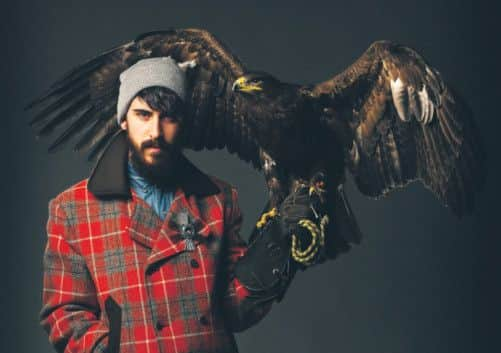Cutting a dash: Dauvit Alexander | Howie Nicholsby


HOW do you define style? It’s about more than fashion, certainly; something less tangible than the latest collections from Milan and not easily acquired with simply a flash of a platinum Amex and a subscription to Vogue.
“I am one of the most unfashionable people imaginable,” says Dauvit Alexander. “I’ve never seen anything in the window of Armani and thought, ‘That’s for me’. But I will mix and match from anywhere. I have a large collection of clothes, from Primark T-shirts through charity shop finds to pieces that have been made for me. It is about having an eye for colour, texture and form and, most importantly, it is about being confident and comfortable.”
Advertisement
Hide AdAlexander, a Glasgow-based metalsmith who creates pieces of jewellery from found items under the brand Justified Sinner, was nominated in the Most Stylish Male category of this weekend’s Scottish Style Awards. He certainly stands out, a not inconsiderable 6 feet 2 ins, with shaved head, lush beard and sporting, more often than not, a splendid Harris Tweed combo.


“My primary material for making jewellery is the unlikely one of corroded iron,” he says. “The main reason for using this is simply that I like the look of it: the pitted, deep grey with flecks of rust which contrasts so well with traditional jewellery materials such as silver and precious stones but there is also a narrative and political dimension.
“Iron is historically a ‘masculine’ material and is a part of the collective psyche of the west of Scotland. As the industry has vanished, there is something poignant about finding scraps of rusted iron – tools, bolts, wire – discarded in abandoned factories and wasteland which was once buzzing with people who made things.
“This iron material comes with an instant ‘history’ which lends to the narrative of the work I make.”
He’s always loved clothes and being well dressed, he says. “I remember being about eight and asking my mum if I could have a suit. I think I was jealous of my dad and his friends who wore suits and smoked cigars, had cars and played cards on a Friday night. They were probably about 32 but I imagined they were 50 and all my life I wanted to be 50 too. Now, as I approach 50, I realise that being this age is better than I could ever have hoped. I can not only wear exactly what I choose but I can have people make the clothes I want.
“There are some really exciting contemporary makers out there who are taking British tailoring forward. For the awards ceremony, I’ve decided to wear everything handmade and British. I’ll be wearing a Harris Tweed jacket by Alan Moore at Scottish label Ten30 – he normally does womenswear and this is his first foray into tailoring for men – as well as one of fellow-nominee Howie Nicholsby’s kilts. My waistcoat, cravat, shoes and socks are all handmade in the UK.”
Advertisement
Hide AdNicholsby, another Most Stylish Male nominee, is the fun-loving dandy behind the Edinburgh-based brand 21st Century Kilts. His stated aim is to “give men throughout the world a realistic alternative to trousers” and, true to his word, his kilts defy the traditional and range from leather and denim to Harris Tweed, camouflage and Savile Row suiting fabrics, like the pinstripe version (£1,100) on the cover of today’s Spectrum. They feature detachable pockets as opposed to the sporran, and clients have included Robbie Williams, Hotel Missoni, Sir Chris Hoy, Lenny Kravitz, Vin Diesel, Alan Cumming, Brian Cox and Mario Testino.
Nicholsby joined the family kilt business in 1996 and took a course in traditional hand-sewn kilt-making. But influenced by the club scene, in particular by album covers from Cream and Ministry of Sound, he was destined for the subversive side of the street, and his first alternative kilt was one made from silver snakeskin PVC.
Advertisement
Hide Ad“The philosophy behind 21st Century Kilts is to take it away from a diluted Victorian etiquette formal piece and allow the garment to be taken back to its original roots of everyday clothing,” he says. n
Twitter: @Ruth_Lesley